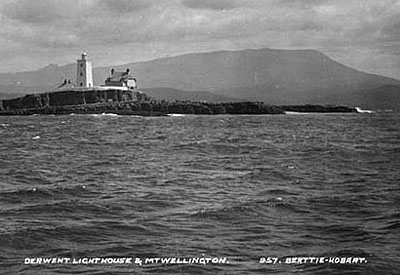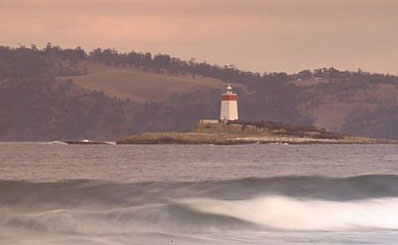
The Iron Pot lighthouse is the oldest tower that is still existing. Although the Macquarie light in NSW was built earlier, in 1818, that tower was rebuilt in 1883. The tower on Iron Pot Island was first lit on September 16 1833.
A year earlier in 1832, a temporary wooden light was built. It was designed by Lieutenant Samual Hill and consisting of 2 perpendicular spars 10 feet apart, with a horizontal headpiece with an elevation of about 50 feet above the highest point of the rock.
The lantern, manufactured in Hobart, was raised and held by halyards. It was first lit on 12 Nov 1832. Three convicts, John Booth, William Spendelon and John Knox tendered to the light. John Booth was placed in charge and received a shilling a day with a promise of conditional pardon after 2 yrs service; he stayed for 9. The island was visited weekly, but rations were supplied monthly. The keepers lived in tents until construction of a stone hut began in late November 1832.
A permanent tower was designed by Civil Engineer, John Lee Archer. It was three storeys high, of rough rubble work, building in the perpendicular spars erected by Lieut. Hill and using the horizontal headpiece for the purpose of hoisting materials. The new light was lit for the first time on the 16th January 1833 and has shone every night since.
The first light was a fixed light with 9 parabolic reflectors consuming 3 gallons of sperm whale oil each night. It was the first lighthouse in Australia to utilise locally manufactured optical apparatus. In September 1834 the Port Officer wrote to the Colonial Secretary requesting a lantern with apparatus for a revolving light be ordered from England, but it was not installed until 1851.
In January 1883 the Marine Board ordered a 4th order dioptric fixed light and a 4th order lantern from Messrs. Chance Bros, England. And this arrived on the steamship "Orient" and was exhibited in February 1884.
It is not known for sure how the name "Iron Pot" originated. Some say a large cauldron was found on the island, possibly used by whalers to boil whale blubber, others say that whalers left their iron pots on the island when returning to their home ports, making more room for whale oil. It has also been noted that pot holes on the island resemble whalers tri-pots. The name of the lighthouse was officially re-named the "Derwent Lighthouse" in June 1884, but most people, even in some official documents, still use the name "Iron Pot"
In 1885 tenders were called, for a 2 storey house designed by Mr R H Stabb.
There was one child born on the island, a daughter - Elsie Margaret - to Head Keeper
Roberts in December 1894. The Roberts later moved to Swan Island.
On the night of Saturday 22nd September 1895, a violent storm lashed the south-east coast of Tasmania, unprecedented since the establishment of the lighthouse. The Launceston Examiner reported on the damage suffered:
|
|
"... the storm of Saturday last, rendered the keepers quarters unsafe, and did damage which will take some hundreds of pounds to right. About 11.00 pm. on Saturday, a tremendous sea broke over the rock, smashed some of the windows and poured over the balcony of the lighthouse, the top which is about 90 ft. above high water mark. The light was unaffected, however, and beamed out brightly across the troubled waters. Over 90 ft. of a stone wall, 3 ft. 6 in. high, which protects the lighthouse on its southern side, was washed away like some sand. The sea continued to break over the rock on which the lighthouse and quarters are built, flooded the keepers house and moved two of them 3 ft. from their foundations. ... about midnight, the huge wooden store shed was washed away into the sea, going with a great crash at one sweep. ... five of the water tanks also went, leaving only two for drinking purposes. Repairs will be effected immediately and no time will be lost in making the houses habitable and safe."
The de-manning of the lighthouse was announced in a notice to mariners dated 25/3/1920 - that the fixed white light on Iron Pot Island, Derwent River, will be replaced by a group flashing white light, unwatched, on or about 31 7 1920. The last keepers, Mr R J Johnston, Snr Assistant J Creese and Temporary Junior Assistant T Lutterell were withdrawn. The cottages were dismantled and the timber sold for use in other buildings around Hobart.
In January 1977 the lighthouse was converted to solar power running a Tideland ML300 light. This was the first time Solar power was used in an Australian Lighthouse.

| Head Keepers |
| John Booth |
1832-1841 |
| John Pocke |
1841-1843 |
| Henry Douglas |
1843-1858 |
| William Johnson |
1858-1863 |
| A C Rockwell |
1863-1864 |
| Joseph Oliver |
1864-1874 |
| JC Parkinson |
1874-1887 |
| EJ Howard |
1887-1891 |
| R Roberts |
1891-1896 |
| C Hemsley |
1896-1897 |
| H Nas |
1897-1899 |
| S Grundy |
1899 |
| H Boon |
1899-1903 |
| C Brown |
1903-1904 |
| H Boon |
1904-1913 |
| EG Roberts |
1913-1916 |
| HG Jacobs |
1916-1918 |
| RJ Johnson |
1918-1920 |
|